What Is Content Strategy? A 2025 Guide for Businesses


Content now drives more than half of all business growth online. That alone might sound impressive. Yet here is the twist. Most brands are still missing the mark because their content is not connected to any clear strategy. With audiences and algorithms evolving every month, knowing how to build a winning content strategy in 2025 is what separates those who stand out from those who fade away.
Table of Contents
- Core Elements Of Content Strategy
- Why Content Strategy Matters For Growth
- How To Build A Winning Content Plan
- Content Strategy Tips For 2025 Success
Quick Summary
| Takeaway | Explanation |
|---|---|
| Define Clear Strategic Objectives | Establish specific, measurable goals that align with broader business outcomes to guide your content strategy effectively. |
| Understand Your Audience | Develop comprehensive audience personas that capture not only demographics but also psychological insights and content consumption habits. |
| Implement Systematic Content Management | Create workflows, editorial guidelines, and performance tracking systems to optimize content creation and management processes. |
| Embrace Technology and Adaptability | Leverage AI for personalized content experiences and maintain flexibility in content planning to respond to market changes swiftly. |
| Focus on Human-Centered Content Design | Prioritize authentic storytelling and empathy in your content to create meaningful connections with your audience. |
Core Elements of Content Strategy
Content strategy represents a comprehensive approach to planning, creating, and managing content that drives meaningful engagement and achieves business objectives. Understanding its core elements is crucial for businesses seeking to develop a robust digital presence.
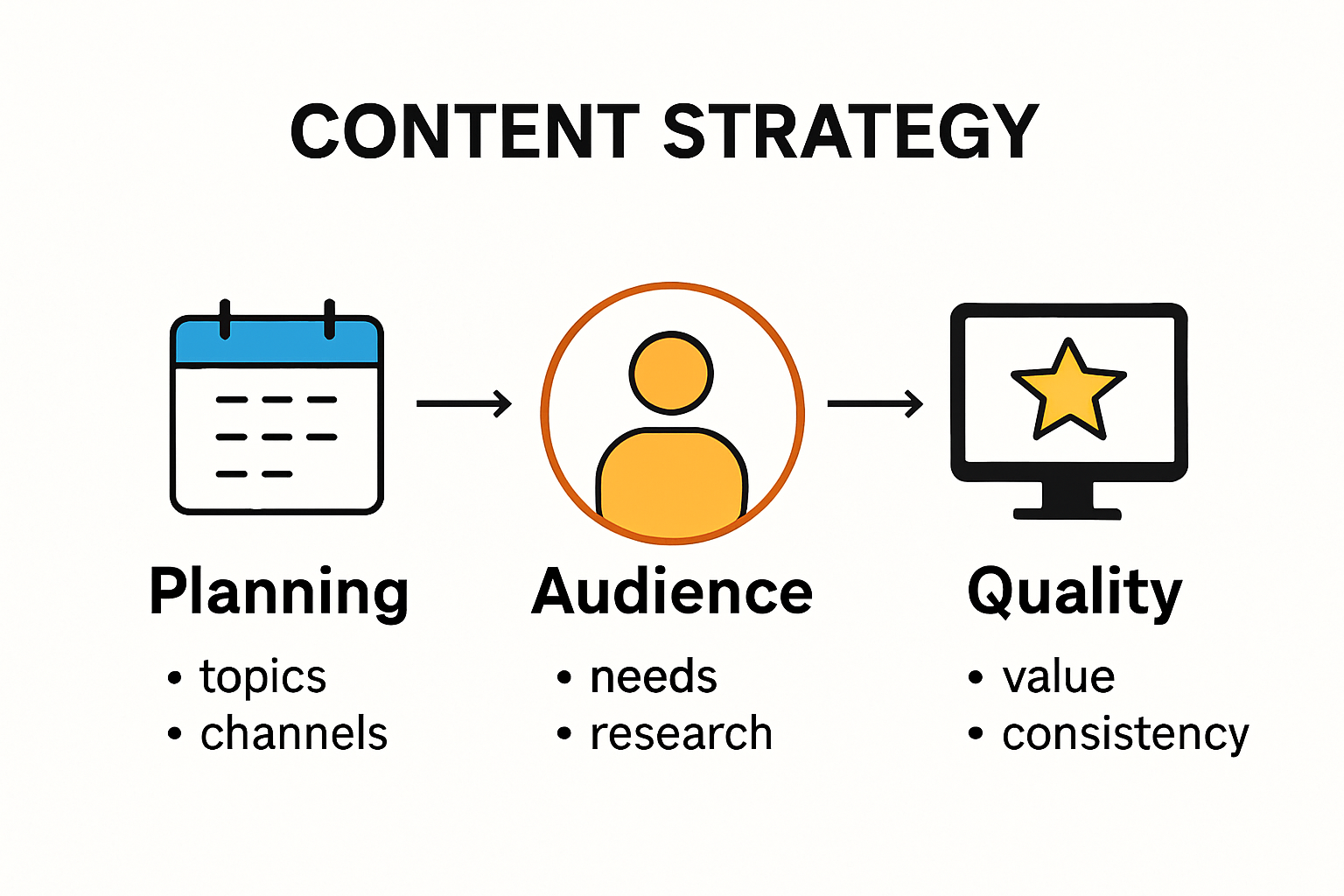
Strategic Foundation of Content Planning
At its core, content strategy is built on five fundamental components that work together to create a comprehensive approach. Expand the Room highlights these critical elements: core strategy, substance, structure, workflow, and governance. Each component plays a unique role in transforming random content efforts into a synchronized system.
The core strategy serves as the strategic blueprint, defining the primary goals and vision for content creation. This involves understanding your target audience, identifying key messaging objectives, and aligning content efforts with broader business strategies. Without a clear strategic direction, content becomes fragmented and loses its potential impact.
Audience and Content Quality
Columbia University's Content Strategy Resource emphasizes that effective content strategy goes beyond mere creation. It requires a deep understanding of target audience needs, preferences, and behaviors. This means developing content that not only attracts attention but provides genuine value.Quality becomes the cornerstone of successful content strategy. This involves:
- Relevance: Creating content that directly addresses audience questions and challenges
- Authenticity: Developing a consistent brand voice that resonates with your target market
- Educational Value: Providing insights that help audiences solve problems or gain knowledge
Systematic Content Management
A robust content strategy also demands systematic management. This includes establishing clear workflows for content creation, defining editorial guidelines, and creating processes for content review and optimization. Organizations must develop mechanisms to track content performance, gather audience feedback, and continuously refine their approach.

By integrating these core elements, businesses can transform content from a tactical exercise into a strategic asset that drives engagement, builds brand authority, and supports overall business objectives. The most successful content strategies are those that remain flexible, data-driven, and closely aligned with evolving audience needs.
Here is a summary table that organizes the core elements of content strategy and their main roles, making it easier to scan and understand how each contributes to a successful strategy:
| Core Element | Main Focus | Key Role in Strategy |
|---|---|---|
| Core Strategy | Vision, goals, audience, messaging objectives | Strategic blueprint for all content efforts |
| Substance | Content topics, style, tone | Guides what content is created and how it is expressed |
| Structure | Organization, hierarchy, taxonomy | Arranges content for usability and consistency |
| Workflow | Processes, roles, timelines | Ensures efficient production and collaboration |
| Governance | Guidelines, policies, review processes | Maintains quality, compliance, and continuous improvement |
Why Content Strategy Matters for Growth
Content strategy has transformed from a tactical marketing approach to a critical driver of business growth. Modern organizations recognize that strategic content creation is not just about producing materials, but about creating meaningful connections that propel business objectives forward.
Aligning Content with Business Goals
Coursera highlights that a well-defined content strategy serves as a strategic roadmap, ensuring every piece of content directly supports specific business objectives. This alignment means content becomes more than just information 4 it becomes a powerful tool for achieving targeted outcomes like increasing brand awareness, generating leads, or driving conversions.Businesses that integrate content strategy strategically can expect significant benefits:
- Targeted Messaging: Creating content that speaks directly to customer pain points
- Measurable Outcomes: Establishing clear metrics to track content performance
- Resource Optimization: Reducing wasteful content creation efforts
Building Brand Authority and Trust
Drexel University's Lebow College emphasizes that consistent, high-quality content builds brand credibility. When businesses deliver valuable, relevant information, they establish themselves as thought leaders in their industry. This trust translates directly into customer loyalty and increased engagement.The process of building authority involves creating content that:
- Demonstrates deep industry knowledge
- Provides actionable insights
- Addresses complex customer challenges
SEO and Organic Growth
Search Engine Land reveals that strategic content creation is a powerful driver of search engine optimization (SEO). By producing high-quality, relevant content that matches user intent, businesses can significantly improve their organic search rankings. This approach not only increases website visibility but also attracts more qualified traffic.Strategic SEO-focused content helps businesses:
- Improve search engine rankings
- Increase website traffic
- Attract more qualified leads
Effective content strategy goes beyond traditional marketing approaches. It represents a holistic approach to communicating value, building relationships, and driving sustainable business growth. By treating content as a strategic asset, organizations can create meaningful connections that translate directly into business success.
How to Build a Winning Content Plan
Building a winning content plan requires strategic thinking, meticulous research, and a systematic approach that transforms abstract goals into actionable content strategies. Success hinges on creating a comprehensive roadmap that guides content creation while remaining adaptable to changing business needs.
Define Clear Strategic Objectives
University of Minnesota emphasizes that developing a robust content strategy begins with defining explicit goals. These objectives must be specific, measurable, and directly aligned with broader business outcomes. Whether your aim is increasing brand awareness, generating leads, or establishing thought leadership, each goal must have clear metrics for tracking progress.Key considerations for setting strategic objectives include:
- Specificity: Creating precise, quantifiable goals
- Alignment: Ensuring content objectives match business strategy
- Measurability: Establishing clear key performance indicators
Audience Research and Persona Development
Understanding your target audience represents the cornerstone of an effective content plan. Texas State University Web Guidelines recommends developing comprehensive audience personas that go beyond demographic information. These personas should capture psychological insights, pain points, content consumption habits, and potential challenges your audience encounters.
Effective audience research involves:
- Demographic Analysis: Understanding age, location, professional background
- Behavioral Insights: Mapping content consumption patterns
- Psychological Profiling: Identifying motivations and decision-making triggers
Content Planning and Execution Framework
A winning content plan requires a structured approach to content creation, distribution, and optimization. This involves developing a content calendar, establishing consistent production workflows, and creating systems for continuous performance evaluation.
Critical components of an execution framework include:
- Content Ideation: Generating topics that resonate with audience needs
- Production Workflow: Establishing clear roles and timelines
- Distribution Strategy: Identifying optimal channels for content sharing
- Performance Tracking: Implementing analytics to measure content effectiveness
Successful content planning transcends simple content creation. It represents a holistic approach to understanding audience needs, creating valuable experiences, and driving meaningful engagement. By developing a flexible yet structured content plan, businesses can transform their digital communication from sporadic efforts into a strategic, results-driven approach.
Here is a process table summarizing the key steps for building a winning content plan, mapping each stage to its focus and desired outcome:
| Step | Main Focus | Desired Outcome |
|---|---|---|
| Define Strategic Objectives | Set specific, measurable, aligned goals | Clear direction and goals |
| Audience Research & Persona Development | Deep understanding of audience demographics, behavior, and psychology | Accurate personas and insights |
| Content Planning & Execution Framework | Structure content creation and workflows | Efficient, consistent content creation |
| Performance Tracking and Optimization | Monitor results and refine strategy | Continuous improvement and ROI |
Content Strategy Tips for 2025 Success
As digital landscapes continue to evolve, content strategy requires adaptive approaches that leverage emerging technologies and changing audience expectations. Staying ahead in 2025 demands a forward-thinking methodology that combines innovation, technological insight, and strategic planning.
Embracing AI and Technological Integration
UK Digital Government Blog emphasizes the critical importance of collaborative workflows and technological integration in modern content strategies. Artificial intelligence and machine learning are no longer optional but essential tools for creating more personalized, efficient content experiences.Key technological considerations for 2025 include:
- Automated Content Personalization: Using AI to customize content for individual user preferences
- Advanced Analytics: Leveraging machine learning for deeper content performance insights
- Predictive Content Design: Anticipating user needs before they articulate them
Adaptive Content Development
University of Kentucky Communications highlights the significance of flexible content planning that responds quickly to changing market dynamics. Successful strategies in 2025 will require rapid iteration, continuous learning, and a willingness to experiment with emerging content formats.Effective adaptive strategies involve:
- Agile Content Frameworks: Creating processes that allow quick content pivots
- Cross-Platform Optimization: Designing content that seamlessly works across multiple digital environments
- Continuous Learning Mechanisms: Implementing robust feedback loops for ongoing improvement
Human-Centered Content Design
Despite technological advancements, human connection remains paramount. The most successful content strategies will balance technological efficiency with genuine emotional resonance. This means creating content that not only delivers information but also builds meaningful connections with audiences.
Critical elements of human-centered content design include:
- Authentic Storytelling: Prioritizing narrative depth over algorithmic optimization
- Empathy-Driven Content: Understanding and addressing genuine user challenges
- Transparent Communication: Maintaining clarity and honesty in all content interactions
Navigating content strategy in 2025 requires a holistic approach that integrates cutting-edge technology with profound human understanding. By remaining adaptable, technologically savvy, and deeply committed to audience needs, businesses can create content experiences that truly stand out in an increasingly complex digital ecosystem.
Frequently Asked Questions
What is content strategy?
Content strategy is a comprehensive approach to planning, creating, and managing content to drive meaningful engagement and achieve business objectives. It involves understanding the target audience, defining key messaging, and aligning content efforts with broader business goals.
Why is a content strategy important for businesses?
A content strategy is crucial for businesses as it ensures that every piece of content supports specific business objectives, builds brand authority, and enhances SEO for organic growth. It helps in creating targeted messaging, measuring outcomes, and optimizing resources effectively.
How can I build a winning content plan?
To build a successful content plan, start by defining clear strategic objectives aligned with your business goals. Conduct thorough audience research and develop personas, then create a structured content planning and execution framework for efficient production and distribution.
What trends should I consider for content strategy in 2025?
In 2025, businesses should embrace AI for personalized content experiences, adopt adaptive content development that allows for quick responses to market changes, and focus on human-centered content design that prioritizes authentic storytelling and empathy to connect meaningfully with audiences.
Supercharge Your Content Strategy With Effortless AI Automation
You have just learned that mastering content strategy in 2025 means keeping up with evolving audience needs, aligning every post with your business goals, and optimizing for organic growth. But if manual planning and endless writing are holding you back from true progress, you are not alone. Many business owners struggle to deliver consistent quality while staying ahead of competitors.

Instead of letting content overwhelm your team, see how BabyLoveGrowth.ai can transform your entire process. Our AI-powered platform gives you:
- A thorough business and competitor analysis so your content matches your unique market
- A customized 30-day content plan designed for your goals
- Instant generation of SEO-optimized articles that rank and engage
Take charge of your growth by boosting authority, driving organic traffic, and freeing up time to focus on your core business. Visit BabyLoveGrowth.ai now and start building a content strategy that works for you this year. Don’t wait—let your content become your strongest asset today.
Smart SEO,
Faster Growth!
Most Read Articles
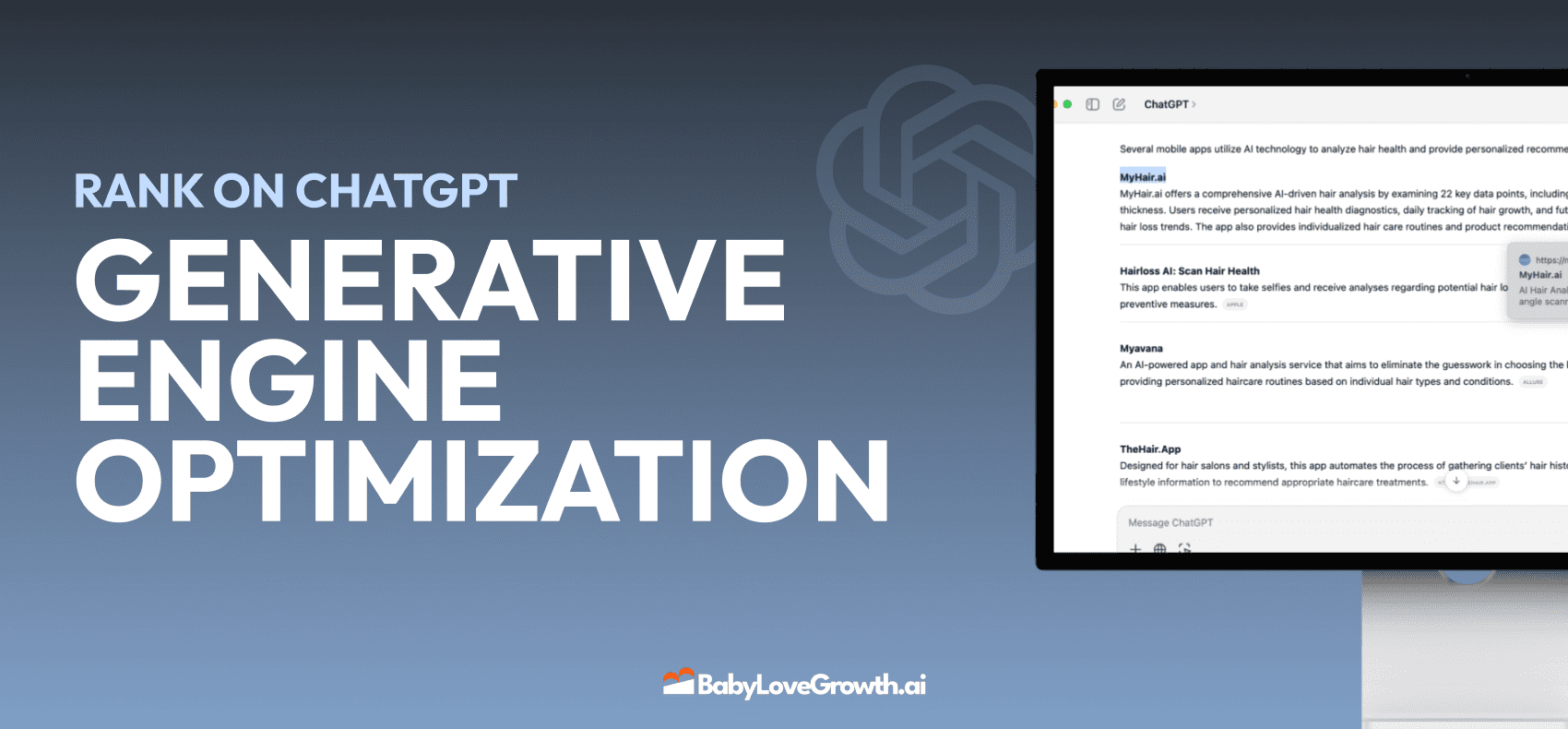
Generative Engine Optimization (GEO)
Learn how Generative Engine Optimization (GEO) helps your content rank in AI search engines like ChatGPT and Google AI. This comprehensive guide explains the differences between SEO and GEO, why it matters for your business, and practical steps to implement GEO strategies for better visibility in AI-generated responses.
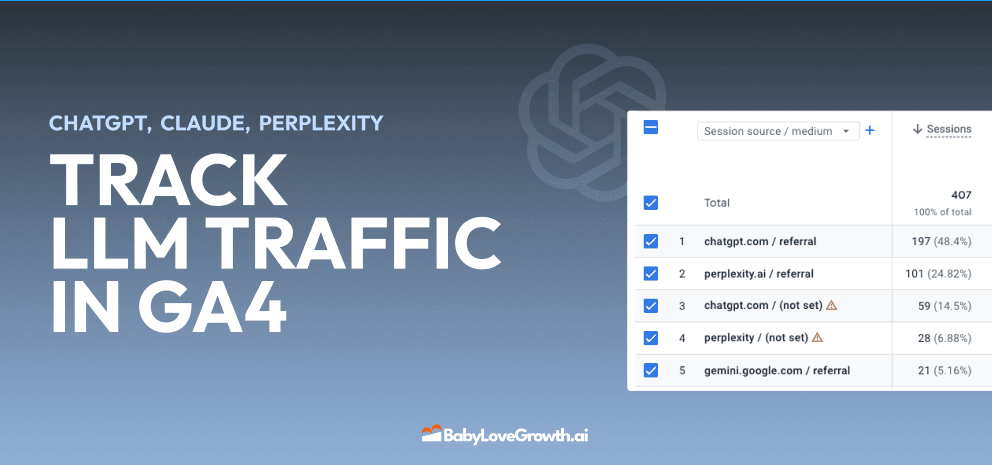
Track LLM Traffic in Google Analytics 4 (GA4)
Learn how to track and analyze traffic from AI sources like ChatGPT, Claude, Perplexity, and Google Gemini in Google Analytics 4. This step-by-step guide shows you how to set up custom filters to monitor AI-driven traffic and make data-driven decisions for your content strategy.
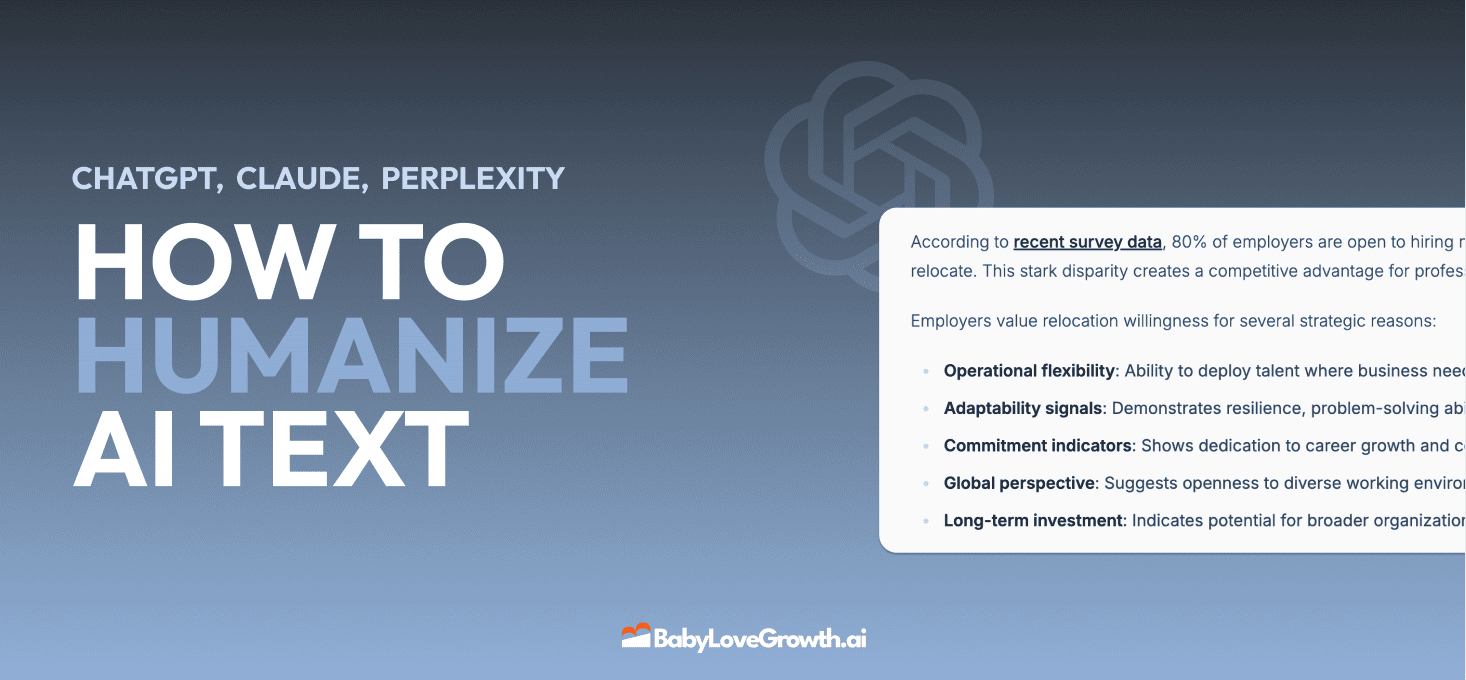
How to Humanize AI Text with Instructions
Learn practical techniques to make AI-generated content sound more natural and human. This guide covers active voice, direct addressing, concise writing, and other proven strategies to transform robotic text into engaging content.
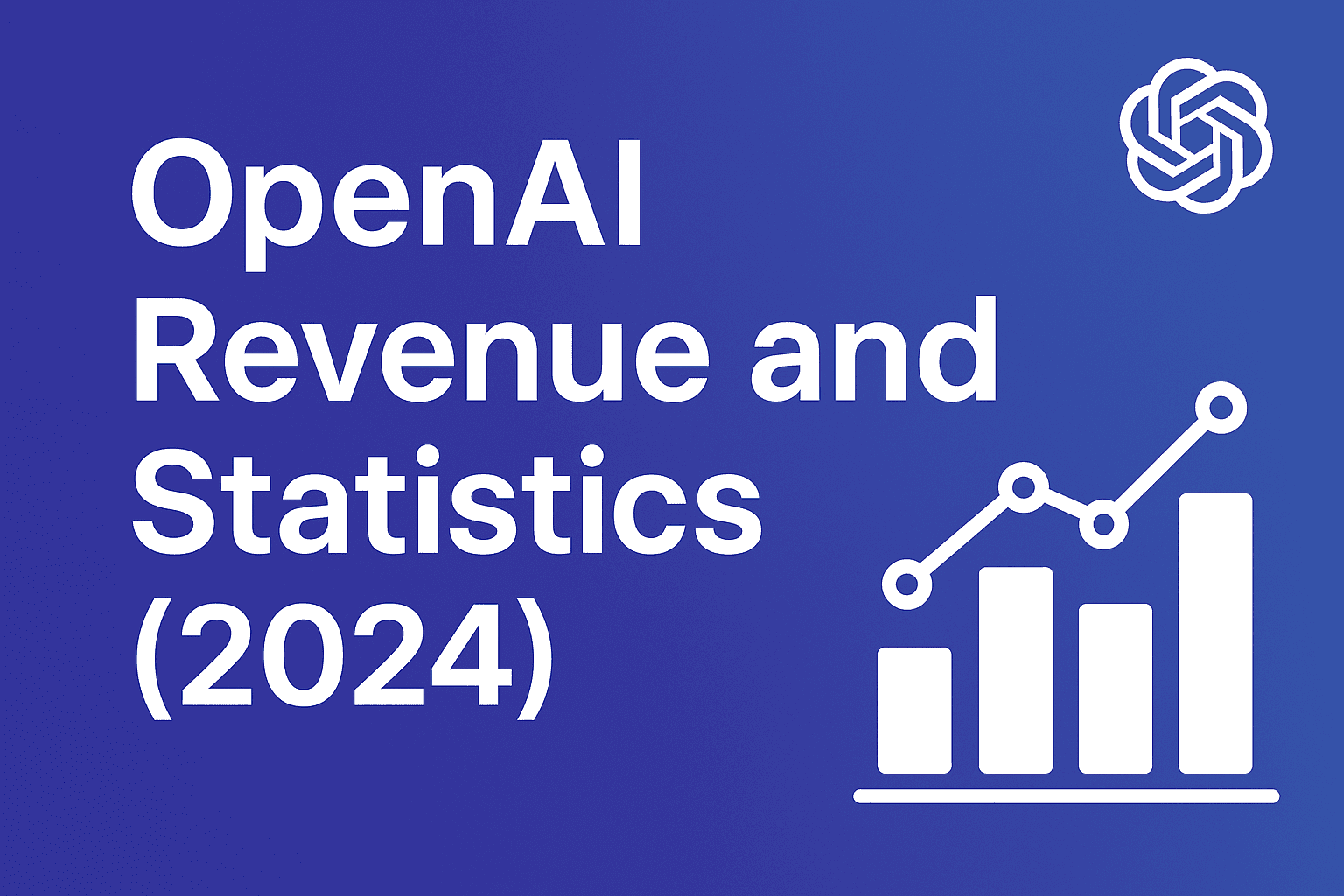
Open AI Revenue and Statistics (2024)
Comprehensive analysis of OpenAI financial performance, user engagement, and market position in 2023. Discover key statistics including $20B valuation, $1B projected revenue, and 100M+ monthly active users.